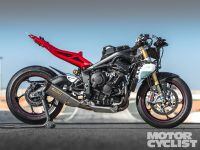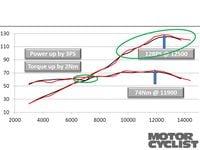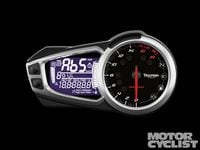Fresh off the press launch for the 2013 Daytona 675R at Circuito Cartagena in Spain, I'm relieved to report that Triumph didn't screw up. The previous 675R was so good-it's dominated every comparison test we've put it in-that I had a hard time imagining how Triumph would be able to make improvements without undermining the bike's performance, poise, and charisma.
Thankfully, the Hinckley folks are bigger visionaries and better engineers than I assumed. They didn't just update the Daytona, they completely rebuilt it, giving it more power, honing chassis balance, and cutting weight in the process. After spending a full day aboard the new 675R, I'm pleased to say that my fears were unfounded: The new Daytona 675R is better than ever.
Numerous engine changes (most notably a greater bore and shorter stroke) give the new Daytona a higher redline (14,400 rpm instead of 13,900 rpm) and more peak power. The midrange feels as robust as ever, and while short-shifting is still an advisable strategy, the new motor has more usable over-rev than before. All U.S.-bound Daytonas will come with switchable ABS, with an unobtrusive Circuit mode that lets you skate the rear tire during corner entry.
Refined quickshifter programming makes upshifting seamless at high and low engine speeds, and with the addition of an "assist and slip" clutch (as on the Kawasaki ZX-6R and Ninja 300) downshifts are now as effortless and drama-free as upshifts. Bang a double-downshift while braking into a bend, and the back end wags once and then falls in line. There's no chatter or slide to distract you from nailing your apex and getting back on the gas.
The chassis was overhauled as well. The wheelbase is shorter, the head angle is steeper, and there's less trail, giving the 675R shockingly aggressive geometry (rake is just 22.9 degrees, trail a mere 3.4 inches) and extremely quick steering. Yet the machine hasn't lost any of its composure, which is to say it's nearly imperturbable-making it incredibly accommodating and confidence-inspiring to ride. A focus on mass-centralization finds the muffler relocated under the engine, while lighter wheels, a lighter rear brake setup, headlight assembly, and fairing stay reduce weight near the bike's perimeter and help it change direction faster and with less effort. Cartagena's many tight transitions made that characteristic wonderfully evident, while the motor's linear power delivery and distinct three-cylinder howl make it endlessly exciting to hammer.
I was worried that Triumph would mine the Daytona's midrange to bolster its peak power or otherwise compromise the 675R's character, but the bike hasn't lost a bit of charm and is even easier and more satisfying to ride. I didn't get to ride the base model bike, but that machine is equally new for 2013. It gets the same engine, and its own suspension and brake updates. I can't wait to get one of these on the street back home in the states.




















/cloudfront-us-east-1.images.arcpublishing.com/octane/VZZXJQ6U3FESFPZCBVXKFSUG4A.jpg)
/cloudfront-us-east-1.images.arcpublishing.com/octane/QCZEPHQAMRHZPLHTDJBIJVWL3M.jpg)
/cloudfront-us-east-1.images.arcpublishing.com/octane/HXOUJXQWA5HBHGRO3EMJIGFMVI.jpg)

/cloudfront-us-east-1.images.arcpublishing.com/octane/3TIWWRV4JBBOLDVGRYECVVTA7Y.jpg)
/cloudfront-us-east-1.images.arcpublishing.com/octane/KIX5O23D5NAIBGFXBN3327DKZU.jpg)
/cloudfront-us-east-1.images.arcpublishing.com/octane/7GJYDUIPXRGMTMQKN6ONYOLBOU.jpg)
/cloudfront-us-east-1.images.arcpublishing.com/octane/MUQLOVLL2ZDGFH25ILABNBXKTI.jpg)
/cloudfront-us-east-1.images.arcpublishing.com/octane/TNOU5DNE2BC57MFPMGN2EIDXAM.jpg)
/cloudfront-us-east-1.images.arcpublishing.com/octane/GTCXACQGJ5HAPDTGWUQKDEH44E.jpg)
/cloudfront-us-east-1.images.arcpublishing.com/octane/S35YGSEMEZB4BLTDJTSZPF4GLA.jpg)
/cloudfront-us-east-1.images.arcpublishing.com/octane/5UOT6HPX2JFMRJAX6EH45AR4MQ.jpg)
/cloudfront-us-east-1.images.arcpublishing.com/octane/OKWOJWAKP5EP3OACCRRWPCIX2Q.jpg)
/cloudfront-us-east-1.images.arcpublishing.com/octane/2WF3SCE3NFBQXLDNJM7KMXA45E.jpg)
/cloudfront-us-east-1.images.arcpublishing.com/octane/G4MG6OUCJNBSHIS2MVVOTPX65E.jpg)
/cloudfront-us-east-1.images.arcpublishing.com/octane/IIGGWFOTOJGB7DB6DGBXCCMTDY.jpg)
/cloudfront-us-east-1.images.arcpublishing.com/octane/QSTCM6AVEZA5JJBUXNIQ3DSOF4.jpg)
/cloudfront-us-east-1.images.arcpublishing.com/octane/U4I7G625B5DMLF2DVIJDFZVV6M.jpg)
/cloudfront-us-east-1.images.arcpublishing.com/octane/B6XD6LS6IVCQPIU6HXDJSM3FHY.jpg)
/cloudfront-us-east-1.images.arcpublishing.com/octane/ICL63FEDDRDTTMINYICCEYGMDA.jpg)
/cloudfront-us-east-1.images.arcpublishing.com/octane/FCGZHQXRBZFLBAPC5SDIQLVF4I.jpg)
/cloudfront-us-east-1.images.arcpublishing.com/octane/WNOB6LDOIFFHJKPSVIWDYUGOPM.jpg)

/cloudfront-us-east-1.images.arcpublishing.com/octane/X33NU3E525ECRHXLNUJN2FTRKI.jpg)